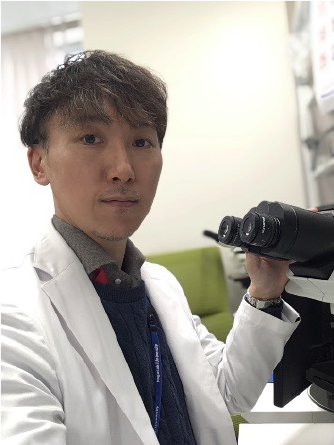 |
| Tissue and Histopathology Section |
|
 |
| |
 |
|
| Hirokazu Kurohama, Assistant Professor |
|
|
| Title & Licence : |
M.D., Ph.D.
- Board Certified Pathologist of the Japanese Society of Pathology, Board Certified Trainer of the Japanese Society of Pathology
- Board Certified Cytopathologist of the Japanese Society of Clinical Cytology
|
| Special field : |
- Human pathology
- Experimental Pathology
- Radiation life sciences
|
Educational
background : |
- Graduation of Nagasaki University School of Medicine, 2010
- Completion of Nagasaki University Graduate School of Biomedical Sciences, 2021 |
Work
experience : |
- Resident, Nagasaki University Hospital, 2010
- Resident, National Hospital Organization Nagasaki Medical Center, 2011
- Clinical Fellow, Department of Laboratory Medicine, National Hospital Organization Nagasaki Medical Center, 2012
- Assistant, Regional Pathological Diagnosis Support Center, Nagasaki University Hospital, 2020
- Assistant Professor, Department of Pathology, Nagasaki University Hospital, 2021 |
Academic
Society : |
- The Japanese Society of Pathology(Councilor)
- The Japanese Society of Clinical Cytology
- Japan Endocrine Pathology Society
- The Japan Thyroid Pathology Society |
| Research Activities |
 |
|
▼Elucidation of mechanisms of radiation-induced carcinogenesis using the Nagasaki A-bomb Survivor Tumor Tissue Bank and Autopsy Archives of Thorotrast exposure
Epidemiological studies of A-bomb survivors have revealed an association between radiation exposure and various types of cancer risk, but to date, no biological indicators have been identified that can distinguish “true” radiation-induced cancers from those that are not caused by radiation. Since 2008, ABDI has been collecting fresh-frozen tissue samples of tumors and normal tissues from A-bomb survivors as the "Nagasaki A-bomb Survivor Tumor Tissue Bank" and has collected 854 samples (as of December 2022). In collaboration with Dr. Fukumoto of RIKEN, we are also constructing an autopsy tissue archive of cases of internal exposure to Thorotrast, a radioactive angiographic contrast agent. Using these samples, we are analyzing the molecular pathological characteristics of radiation-induced cancers by whole genome analysis using next-generation sequencers and gene mutation signature analysis techniques. In addition, we are searching for radiation exposure-specific markers and elucidating radiation carcinogenesis mechanisms using animal models of radiation carcinogenesis. We have previously shown that multiple gene expression changes occur in the radiation-exposed thyroid gland of rats before carcinogenesis, including the CDKN1A gene, which is a cell cycle regulator (Kurohama. J Rad Res 2021). These studies are expected to be useful in understanding the characteristics of radiation-induced cancer and its control, in assessing an individual's risk of cancer after radiation exposure.
▼Pathology of thyroid cancer focusing on cell connecting and polarity
Thyroid cancer is classified into two types: differentiated carcinomas (papillary and follicular carcinomas), which have a relatively good prognosis, and poorly differentiated and anaplastic carcinomas, which have a poor prognosis. It has been suggested that poorly differentiated and anaplastic carcinomas may be multi-step carcinogenesis caused by the addition of p53, β-catenin, or TERT promoter mutations to differentiated carcinomas, but the detailed mechanism is not well understood. The prognosis for anaplastic carcinoma is very poor, so early detection and treatment strategies prior to dedifferentiation are important. Among the various morphological subtypes of differentiated carcinoma, we are particularly interested in morphological changes such as decreased cell connectivity, polarity disruption, and stromal reaction, which may be associated with high-grade transformation and molecular abnormalities. This study is expected to elucidate the mechanisms of de-differentiation and high-grade transformation of thyroid cancer and to contribute to the construction of better therapeutic strategies for thyroid cancer.
|
|
|
|
|

